Tile rugs are an innovative and stylish way to add visual interest to your floors while maintaining durability and easy maintenance. In this article, we’ll explore six inspiring tile rug designs that combine style with practicality, perfect for adding a touch of elegance to your home.
Choosing Materials With a Good Grip
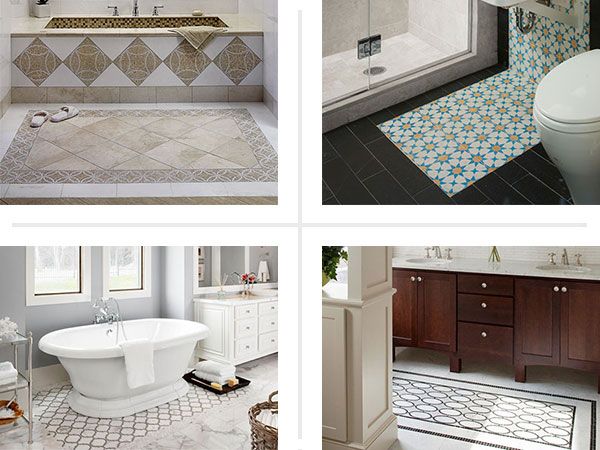
When designing a tile rug, consider incorporating slip-resistant materials or textures to increase safety, especially in areas prone to moisture, like bathrooms or kitchens.
Tile rugs can be particularly beneficial in high-traffic areas, where the slip-resistant texture or finish helps mitigate falling risk. You can opt for materials such as textured porcelain or anti-slip coatings to maximize grip. These materials are paramount in households with young children or elderly family members so the rug doesn’t compromise safety.
Tread Lightly With a Classic Runner
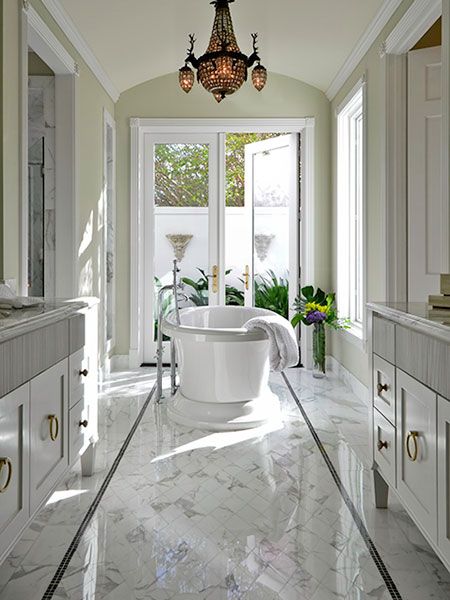
This bathroom design features Artistic Tile’s diamond-shaped Calacatta Gold tiles, exemplifying a subtle yet elegant style. Using the same material as the perimeter tile creates a seamless transition while adding visual interest. The simple black mosaic border effectively delineates the change in tile shape without overwhelming the eye. This design demonstrates how a classic runner pattern can be adapted to tile, offering a sophisticated and durable alternative to traditional fabric runners.
When considering a tile runner for your space, think about the following:
- Complementary colors and materials
- The scale of the pattern in relation to the room size
- Traffic patterns in the room
You can adapt a tile runner to various styles and spaces. Whether installed in a hallway, bathroom, or entrance area, analyze the room’s flow and usage. Coordinating the runner’s colors and patterns with surrounding decor can create harmony even in the busiest spaces, offering a timeless look that merges functionality with style.
Multi-Shape Tile-Rug Border
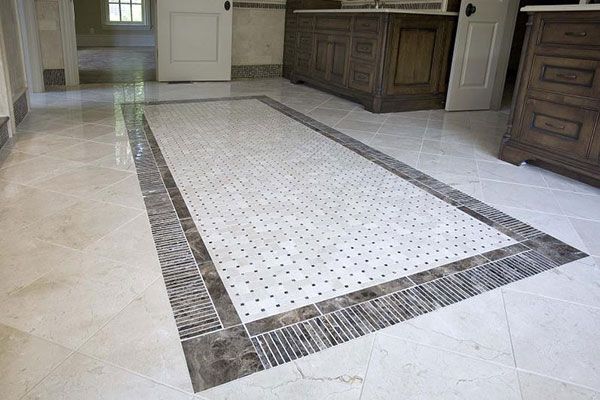
This striking bathroom floor showcases a bold approach to tile rug design. The Mission Stone & Tile Crema Marfil/Emperador Dark Dot basketweave pattern creates a captivating focal point. By mixing rectangles and squares, the design adds depth and visual interest to the space. This multi-shape border technique can be adapted to various styles and color schemes, allowing for personalization while maintaining a classic appearance.
To create a similar effect in your home, consider the following:
- Balancing the intricate rug pattern with simpler surrounding tiles
- Contrasting light and dark tiles for dramatic impact
- Varying tile shapes to create texture and movement
Using multiple shapes in a tile rug design can dramatically change the ambiance of a room. For example, a mix of geometric shapes can draw attention and guide the eye through the design. Homeowners might choose alternating colors or finishes to amplify the dynamic look further. When balanced with simpler surrounding tiles, this approach allows the tile rug to shine without overwhelming the space.
Beige Bathside Tile Carpet
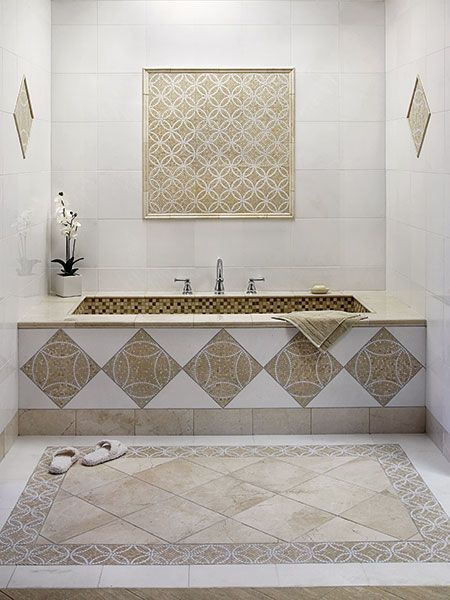
This detailed bath mat design demonstrates how a tile rug can seamlessly integrate with your overall bathroom style. The mosaic pattern echoed on the wall and tub side creates a cohesive look using polished marble from the AKDO Bursa Beige and Thassos collections. This approach adds visual interest and provides a permanent, water-resistant “rug” that complements the bathing area perfectly.
When designing a bathside tile carpet, keep in mind the following:
- Coordination with other bathroom elements
- Ease of cleaning and maintenance
- Water resistance and slip prevention
When integrating a tile rug in a bathroom space, choose materials that can withstand moisture while maintaining safety, such as nonporous and slip-resistant tiles. Matching the tile rug with other bathroom elements like countertops or wall tiles can create a unified and polished look.
Statement Backsplash-Turned-Runner

In this guest bathroom, a bold Marrakesh Design tile installation takes center stage, transforming what could have been a simple backsplash into a stunning floor runner. The intricate pattern and vibrant colors create a focal point in an otherwise neutral space, demonstrating how a tile rug can dramatically alter the character of a room. We recommend leaving this complex type of installation to professionals whose experience can ensure better execution and longevity.
Consider these factors when planning a statement tile runner:
- The overall color scheme of the room
- The scale of the pattern in relation to the space
- The transition between the runner and the surrounding flooring
Adding a statement tile runner can serve as the centerpiece of a room. The vivid colors and intricate patterns can breathe life into an otherwise plain space, highlighting or even redefining the room’s features. When planning such an eye-catching installation, think about how the runner interacts with other design elements, including furniture and wall colors.
Pretty Tile Rug Under a Substantial Soaker
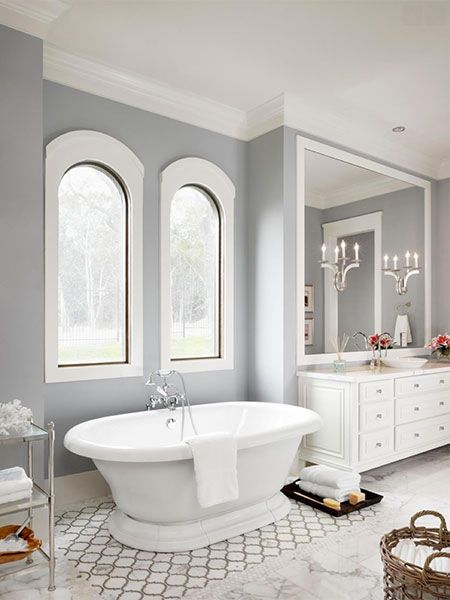
This luxurious bathroom design by Dy Lynne Décor showcases how a tile rug can act as a focal point for a cast-iron tub. The Artistic Tile’s Toledo marble and glass arabesque design creates a trellis-like pattern that complements the elegant bathtub and adds visual interest to the floor. While beautiful, keep in mind that maintaining a tile rug around a tub requires more attention than in other areas due to frequent water exposure.
To successfully incorporate a tile rug under a bathtub, do the following:
- Check for proper sealing to prevent water damage
- Choose a pattern that complements the tub’s style
- Use water-resistant materials and grout
Select water-resistant materials such as glass or glazed tiles and pair them with durable grout for longevity and easy maintenance. Proper sealing protects the floor against water damage, and coordinating the pattern with the tub’s design ties the space together, turning a practical area into an elegant sanctuary.
Space-Defining Marble Rug
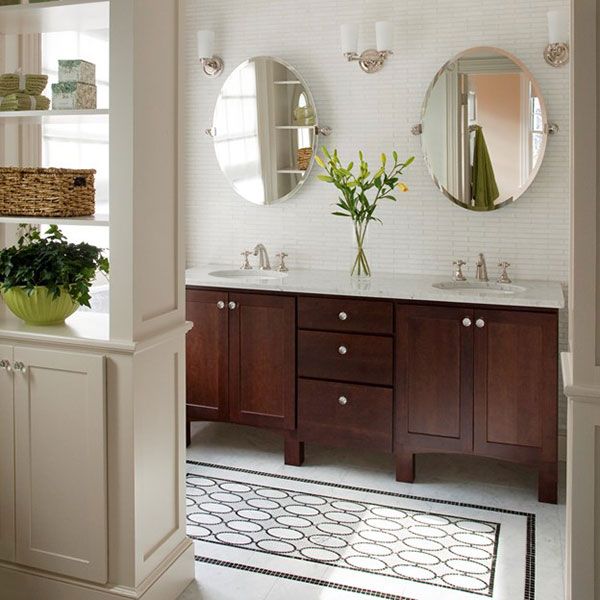
In this sophisticated bathroom, an ANN SACKS Opera mosaic tile rug and storage room divider help define the double-vanity space. This design shows tile rugs’ ability to create distinct zones within one room. The intricate pattern adds texture and interest to the floor, elevating the bathroom’s overall design.
When using a tile rug to define spaces, keep these aspects in mind:
- How the tile design harmonizes with other elements in the space
- The flow of traffic through the room
- The scale of the pattern in relation to the furniture
Tile rugs offer a unique way to define and separate spaces effectively. This technique is valuable in larger areas where distinct zones serve different purposes.
By carefully selecting the scale and pattern of the tile rug, homeowners can create delineation points that guide movement and improve the room’s structure. Aligning the design with surrounding elements such as furniture and decor provides cohesiveness, resulting in a harmonious and stylish space.
